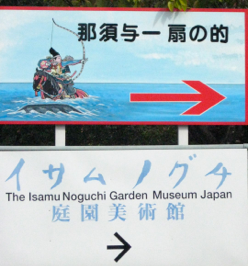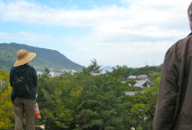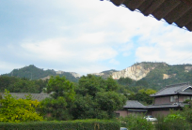The isamu Noguchi Garden Museum japan
Shikoku ISLAND
Village of Mure
KAGAWA DISTRICT , SHIKOKU prefecture
THE SETO INLAND SEA
Japan
OctobeR 25, 2007


The isamu Noguchi Garden Museum japan
Shikoku ISLAND
Village of Mure
KAGAWA DISTRICT , SHIKOKU prefecture
THE SETO INLAND SEA
Japan
OctobeR 25, 2007




Isamu Noguchi (1904-1988), a prominent Japanese-American artist, sculptor, and landscape designer was born, educated, and based in the United States. He maintained a workshop in Japan and spent months at a time working there toward the end of his nearly 65-year long career. Noguchi’s Japanese home and workshop were located in Mure on the island of Shikoku famous for its stone masonry. After Noguchi’s death, the workshop was converted into the Isamu Noguchi Garden Museum where his art, and his studio, and his living space can be seen. It was a dream come true and a minor miracle that Henry and I were able to visit the Isamu Noguchi Garden Museum in Japan. When speaking with the staff at the Benesse Beach House, I confessed to being an artist and having a desire to see Noguchi’s studio, prompting them to make arrangements for Henry and me to to join a tour group there, an island hop away, and just a day and a half later! The Isamu Noguchi Museum Japan is open on Tuesday, Thursday and Saturday by reservation only. On Thursday, we rose at 5:30 AM, skipped breakfast, checked out of our wonderful room at the Benesse Museum, then boarded a Ferry from Miyanoura Port, Naoshima Island to Sunport Takamatsu on Shikoku Island. We arrived on the island by 8 AM, then found a taxi to transport us to The Noguchi Garden Museum. There, we met a group of Americans from San Francisco who were touring Japan with a focus on the nationally treasured art form, Japanese ceramics. The Noguchi museum had a strict “No Photography” policy, so I couldn’t record any of the sculpture or gardens here. This is certainly understandable, since a number of the works were left unfinished. We toured Noguchi’s studio, his home and garden. Although Isamu Noguchi worked in Italy and New York, he used this studio as a place to nurture his creative spirit, to find solitude, and to escape from the world.
• Noguchi’s Workshop is located in an Edo Period storehouse, laid out with his tools as if he were about to enter. Outside the workshop are nearly 150 stone sculptures, many of them unfinished. A dozen finished sculptures are exhibited in the large Meiji Period warehouse that was relocated to these grounds and restored by Noguchi. The largest of his sculptures in this warehouse is a piece entitled Energy Void, a 3.6 meter/12 foot tall sculpture of black Swedish granite that the building was literally built around. Defining this area was a beautiful dry stone wall with large stones anchoring the four-foot depth. the height varying in a gentle curve measuring between 1.2 and 2.1 meters/ 4 to 7 feet in height.
•Noguchi’s Studio is located inside the confines of an undulating wall described above.Beyond the was a large ground, a former rice field, where Noguchi’s studio sanestled amongst some trees. The studio was surrounded by a beautiful flat earth, covered in fine gravel that was raked into horizontal lines defining this area. Toward the back of the property, on one side, sat a barn-like structure, a former sake warehouse filled with completed works by Noguchi. The structure was simple and beautiful. The exterior, white stucco, was capped with a traditional slate-colored tile roof. Inside, old boards and beams were exposed, and an earth and straw mixture filled the gaps between beams, underscoring the simplicity of the space that had aged into a rich tobacco brown color. A few small, high windows punctuated the long walls of the warehouse, their framed rice paper screens emitting a soft light that illuminated the sculpture.• Noguchi’s Workshop is located in an Edo Period storehouse, laid out with his tools as if he
•Noguchi’s House stood outside the protective studio wall. A traditional country-styled Japanese structure, it was purchased by Noguchi and transported to the site in 1969. This 250-year old Edo Period house is considered to be a Japanese National Treasure. As visitors, we were allowed to peer through the doorways and windows to see the interior of the house. Inside, stood a fine, carved bench of old wood. The floors, on varying levels, were covered in tatami mats, while Noguchi’s sculpture and rice paper lamps in his abstract forms, filled the space with sophisticated contrasts of style. Behind the house was a small garden where a grove of large bamboo trees shaded a garden, and some of Noguchi’s rock sculptures were displayed.
•Garden on the Hill was designed by Noguchi to celebrate his 80th birthday. Noguchi laid beautiful, thick, natural stones as steps connecting the two levels. Natural rocks were laid in a grid pattern as a terrace, while other stones were placed around as natural works of art. A white stone arch in two directions defined the curves of the topography, where a steep, gum-drop shaped grass hill met the leveled land. Bamboo trees serve as a screen adding privacy, shielding this garden from the houses and the masonary studios beyond the property. From this perspective, Henry and I could have another glimpse of the Seto Inland Sea
* The Noguchi Museum in New York City is located in Queens. To see Noguchi in Manhattan, visit 140 Broadway for the Red Cube and see the Sunken Garden at One Chase Bank Plaza on Nassau Street between Liberty and Pine Streets. Also, be sure to visit the Noguchi Museum in Queens. The Lobby of 666 Fifth Avenue has a waterfall and ceiling designs executed by Noguchi. One my favorite Noguchi Sculptures is installed at Storm King Sculpture Park in Mountainville, New York. Here, abstract shapes and Noguchi-touched, natural stones caress the edge of a mound behind the museum.
PHOTOS: Left: 1. Interior of the Saki warehouse, the receptions center of the garden museum. 2. View from beneath the eaves of the Saki warehouse, now the museum’s Reception. Center: A sign indicating the direction to the Isamu Noguchi Garden Museum. Right: 1.View from Noguchi’s garden designed by him to celebrate his 80th birthday. 2.View of the environment from the Sake warehouse, the reception area of the garden museum.


CARVED IN STONE

